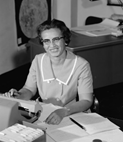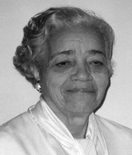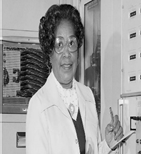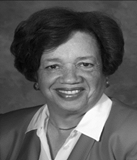
International women’s day is a global day celebrating the social, economic, cultural, and political achievements of women. While we seek out and celebrate women’s achievements, we also “Choose to Challenge” to create radical change and transformation.
Indian and world history is galore with instances of courage shown by women in choosing to challenge and bringing positive changes to the societal norms. As we celebrate the day to act upon accelerating women’s equality, let’s read and get inspired by the stories of African American female mathematicians and engineers-Katherine Goble Johnson, Dorothy Vaughan, Mary Jackson, and Dr. Christine Darden who through sheer tenacity, force of will, and intellect, made their mark in American history.
These African American mathematicians were an integral part of NASA’s space race and the women team of human ‘computers’ who calculated by hand the complex equations that allowed space heroes like Neil Armstrong, Alan Shepard, and John Glenn to travel safely to space.
Katherine Johnson-a mathematician who calculated flight trajectories for various missions, Dorothy Vaughan-NASA supervisor, Mary Jackson-NASA’s first female aeronautical engineer and Dr. Christine Darden– leader of the Sonic Boom Group of NASA’s High-Speed Research Program ‘chose to challenge’ not only gender but racial discrimination too and proved their mettle despite toiling under less than favourable conditions during those times.
Katherine Johnson

Katherine Johnson graduated from high school at 14 and the historically black West Virginia State University at 18. In 1938, as a graduate student, she became one of three students and the only woman to desegregate the University. In 1953, Johnson was hired by National Advisory Committee for Aeronautics (NACA) which became National Aeronautics and Space Administration (NASA) five years later, by the Space Act of 1958.
Johnson’s first big NASA assignment was in 1961 when she computed the trajectories for Alan Shepard’s historic flight. She also contributed to America’s first orbital spaceflight piloted by John Glenn. Glenn wasn’t keen on putting his life in the hands of the computers that would be used to handle the mission on Earth. He asked the head engineers to “get the girl to check the numbers… If she says the numbers are good… I’m ready to go.” Katherine’s intellect was conspicuous in her work.
Katherine Johnson ‘chose to challenge’ overcoming all the hurdles during her initial days in NASA. She worked for over 30 years before retiring in 1986. Katherine Johnson received the Presidential Medal of Freedom in 2015. In 2016, NASA dedicated the Langley Research Center’s Katherine Johnson Computational Building in her honour. When she turned a whopping 100 years old, NASA honoured her by reintroducing a facility in her home state of West Virginia as the Katherine Johnson Independent Verification and Validation Facility.
Dorothy Vaughan

After earning a degree in mathematics and working as a teacher, Dorothy was one of NACA’s early computer hires during World War II. In December 1943 she started working for NACA’s West Area Computing unit, a group of African American female mathematicians who were considered “human computers,” performing complex computations and analyzing data for aerospace engineers. She became a leader and advocate for the “West Computers.” In 1948, she became the then NACA’s first black supervisor and later, an expert FORTRAN programmer. Despite her successes and capability, she was constantly passed over for promotions. She constantly struggled with the same things her colleagues as female computers did while at NASA. She however ‘chose to challenge’ as she knew she was changing the world. She retired from NASA in 1971 and was posthumously awarded the Congressional Gold Medal by the United States in 2019.
Mary Jackson

Jackson went through several career changes before making history at NASA. After graduating with dual degrees in Maths and Physical science Jackson joined the Langley Memorial Aeronautical Laboratory (currently the NASA Langley Research Center) in 1951 and worked in the racially segregated West Area Computing Unit.
After several years working as a human computer, Jackson took an assignment in assisting Kazimierz Czarnecki, a senior aeronautical research engineer who encouraged her to become an engineer herself. To do that, however, she needed to take after-work graduate courses held at segregated Hampton High School. Jackson ‘chose to challenge’ and petitioned the City of Hampton to be able to learn next to her white peers. She won, completed the courses, and was promoted to engineer in 1958, making her NASA’s first African American female aeronautical engineer. Over the next two decades, she worked at several NASA departments, and authored or co-authored 12 technical papers before retiring in 1985. Jackson was posthumously awarded the Congressional Gold Medal by the United States in 2019.
Dr. Christine Darden

Junior to her exceptional predecessors of female pool of human computers at the Langley Research Center, she went on to lead the Sonic Boom Group of NASA’s High-Speed Research Program. Her ground-breaking work laid the foundation for research on experimental planes (known as X-planes) that NASA launched in 2016.
After graduating with master’s degree in applied mathematics in 1967, she was hired as a data analyst in the high-speed aeronautics division at NASA. She was a part of female mathematicians who helped the male engineers create documents about wing and airflow shapes for the military and airplane companies. She found out that males and females with the same background were assigned different roles and females were not encouraged enough to become engineers. She ‘chose to challenge’ when she questioned the director about the same. Eventually, she got promoted to engineering.
She retired from NASA in 2007 after a 40-year career and was awarded the Congressional Gold Medal by the United States in 2019 alongside the other three African American mathematicians for their scientific contributions.
Indeed, these women paved the way for women of colour to make history in the fields of science, math, and technology and are an inspiration to one and all. Their stories first were brought to light by Margot Lee Shetterly in her book Hidden Figures: The American Dream and the Untold Story of the Black Women Mathematicians Who Helped Win the Space Race. The book was later adapted into the movie with the same name Hidden Figures in 2016.
Remember, we all have the power to create a change like these inspirational women did decades ago. Change isn’t just about big headline moments, legal victories, and international agreements: the way we talk, think, and act every day can create a ripple effect that benefits everyone. Let’s all ‘Choose to Challenge’ and work upon creating a change.
